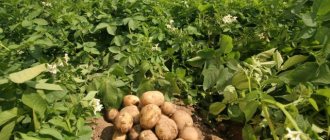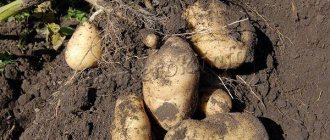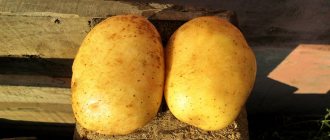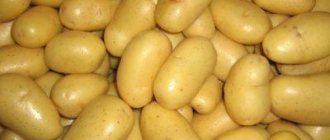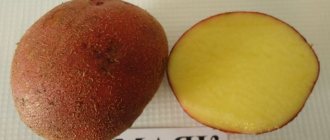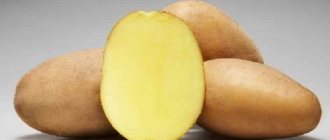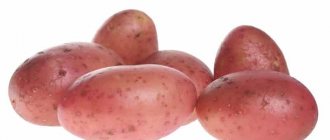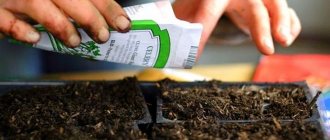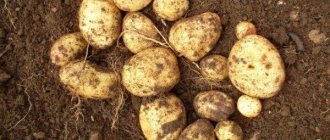Description of the Kiwi potato variety
Kiwi potatoes were developed in the 90s of the 20th century. in the city of Zhukov, Kaluga region. The variety belongs to amateurs, has not passed state tests and therefore information about the hybrid is not available in the State Register of the Russian Federation.
When studying the description of the Kiwi potato variety, gardeners are interested in the question of whether it is GMO or not. This is due to its high resistance to the Colorado potato beetle. In laboratory conditions, plants are obtained that are resistant to pests and diseases. First, the genes responsible for the desired properties are separated, then special bacteria are introduced into the potato cell.
Attention! In Russia there is a ban on growing GMO potatoes outside experimental stations. However, its import, sale and processing are permitted.
All products containing GMOs are tested and labeled. In Russia, the sale of 5 genetically modified potato varieties is permitted. Among them, the Kiwi variety is missing.
According to the description of the variety and photo, Kiwi potatoes ripen at a later date. The period from tuber germination to harvesting takes an average of 125 days. This period of time is affected by soil moisture and weather conditions.
Kiwi bushes reach a height of 50 - 80 cm. The shoots are erect, with a large number of branches. The bushes are well leafy. The leaf blade is elongated, rough, jagged along the edges. The color is bright green. The flowers are lush, deep purple.
Characteristics and photos of the Kiwi potato variety:
- elongated shape;
- rounded edges;
- mesh rough peel;
- white dense pulp.
The hybrid got its name due to the similarity of the root crops to kiwi. At the same time, the potatoes have approximately the same size: medium and large. Small specimens are practically never found. Kiwi potato tubers are rich in fiber and dry matter.
GMO or not?
Due to the phenomenal resistance of the variety to the Colorado potato beetle, many people are concerned about whether Kiwi potatoes are genetically modified. Moreover, some sources categorically claim that this variety is grown using genetic technologies. It is not possible to answer this question unambiguously, since according to official data, only two varieties of genetically modified potatoes have been bred in Russia - Elizaveta Plus and Lugovskoy Plus. They are developed by the Center for Bioengineering of the Russian Academy of Sciences and are prohibited for cultivation, although they are certified for consumption. The above-mentioned varieties have undergone a modification of the gene structure, as a result of which they are not affected by pests - this is what gave reason to assume that Kiwi, which has the same properties, is also GMO.
The Kiwi variety is not damaged by the Colorado potato beetle, which gave reason to consider it transgenic
Most agronomists express the opinion that “normal” potatoes must be damaged by insects, and if pests bypass them, it means that the gene of the bacterium enemy of the Colorado potato beetle was artificially introduced into the tubers. But, contrary to popular belief, it is possible to obtain a variety that is not damaged by pests using ordinary breeding. Such developments were carried out in Russia back in the 1950s, and were based on the principle of crossing ordinary potatoes with wild ones. True, this greatly deteriorated the taste of the tubers, making them practically unsuitable for food. However, progress does not stand still, so over time, breeders have learned to reduce the damage to potato taste to a minimum.
The Colorado potato beetle does not like potatoes for two reasons. Firstly, it contains biofiber (by the way, the result of quite traditional selection methods), which is not absorbed by the beetle’s body, and secondly, the pest is simply not able to lay eggs on the “hairy” leaves of this potato. A large number of small hairs on the shoots is also not evidence of interference in the gene structure (especially considering the fact that Kiwi is a product of amateur selection), so we can conclude that this variety is not transgenic.
In addition to Kiwi, there are several other types of potatoes that are not damaged by the Colorado potato beetle and are obtained through completely conventional selection. Among these varieties are Lasunok, Kamensky, Bryansky and Utro.
Planting and caring for Kiwi potatoes
Following the rules of planting and care will help you get a high yield of Kiwi potatoes. Although the variety is considered unpretentious, its development is positively affected by soil fertility, hilling and watering.
Selection and preparation of a landing site
Kiwi potatoes are planted in a sunny area. The culture prefers neutral soils, but also grows in acidic soils. For growing the Kiwi variety, light or medium soil is best suited: loam, chernozem, sandstone. If the soil on the site is clayey, the tubers will not be able to fully develop.
The potato plot is located from north to south. Lowlands where water and cold air accumulate are not suitable for planting. Excess moisture in the soil increases the risk of disease spread.
The best predecessors for the crop are cucumber, cabbage, beets, and herbs. If tomatoes, potatoes, peppers or eggplants grew in the beds, it is recommended to change the planting location. Soil preparation begins in the fall. The site is dug up to a depth of 30 cm. The soil is cleared of weeds and fertilized with compost and wood ash.
Preparation of planting material
Before planting, it is important to prepare the material. This will increase crop productivity and avoid diseases. For planting, tubers weighing 80 - 100 g are selected. Too small specimens are not suitable, since they will not be able to produce a good harvest.
Attention! If potatoes are chosen for planting in the fall, then they are first kept in the light. Greened tubers last longer.
1 - 1.5 months before planting, the material is transferred to a lighted place. Tubers are germinated at a temperature of +12 °C. Root crops with sprouts 1 cm long are planted in the ground.
Before starting work, Kiwi potatoes are treated with a growth stimulator. The drugs Epin or Zircon are used. For 1 liter of water, 20 drops of the drug are required. The tubers are sprayed with a spray bottle. Treatment stimulates potato growth and increases its resistance to diseases and weather conditions.
If planting material was purchased from hand, it is better to further process it before planting. The tubers are dipped in a 1% boric acid solution. Exposure time – 20 minutes.
Landing rules
Planting potatoes begins when the soil warms up well. The timing depends on the climatic conditions in the region. This is usually the period from late April to mid-May. Tubers are planted in moist soil. The planting depth is chosen taking into account the composition of the soil. On clay soils - no more than 5 cm, in sandy soils - 12 cm.
The procedure for planting Kiwi potatoes:
- Holes or furrows are dug in the area. Between tubers they maintain 30 - 40 cm, between rows - 70 cm.
- A handful of wood ash is placed in each cavity.
- The tubers are lowered into the holes.
- Potatoes are covered with earth.
In addition to the traditional method, other planting options are gaining popularity. One of them is to spread the tubers over the bed and cover them with a thick layer of straw. As the bushes grow, more straw is added. The advantages of this method are the quality of root crops and ease of harvesting. However, potatoes can suffer from lack of moisture and become food for rodents.
Watering and fertilizing
The supply of moisture has a positive effect on the development of potatoes. The crop is not watered until buds form. Then the soil is kept moist. First you need to make sure that the soil is dry by 10 - 12 cm. Water the potatoes in the evening. The water requirement for one bush is 2 liters.
Advice! In regions where precipitation occurs periodically, irrigation is not required. During drought, plantings are watered up to 5 times during the growing season.
Potatoes are fed as needed. Organic matter and minerals are added when planting or digging the soil. Poor soils require additional fertilizing.
For culture, slurry, herbal infusion, urea solution or ammonium nitrate are used. Fertilizers contain nitrogen, which promotes the growth of green mass. This feeding is carried out in June. After 3 - 4 weeks, superphosphate or wood ash is added to the soil.
Loosening and weeding
To successfully grow potatoes, it is important to periodically weed and loosen the soil. As they appear, weeds are removed from the soil. It is convenient to carry out the procedure with a rake.
The first loosening is carried out before the emergence of shoots. Subsequently, the soil is loosened after rain or watering. It is important to prevent a crust from forming on the surface of the earth. As a result, air exchange in the soil improves, plants better absorb moisture and nutrients.
Hilling
Hilling is another mandatory step in crop care. Processing stimulates the emergence of new stolons on which the crop is formed. When hilling, soil from the row spacing is raked under the base of the bush.
Potatoes are hilled twice during the season. The first time is when the bushes reach 15 - 20 cm in height. The next one is 3 weeks before flowering begins. Hilling is carried out after watering or rain.
Agricultural technology
Agricultural methods consist of several inflexible rules that must be observed.
The Kiwi variety is advantageous because it does not degenerate from year to year, but remains even and large.
It is necessary to begin preparing the site for planting in the fall, around the end of September. To do this, plow the top soil layer to a depth of approximately eighteen centimeters. Manure is introduced into the plowed land along with phosphorus and potassium fertilizers.
Top dressing
It is recommended to add nitrogenous fertilizer to make the tubers richer.
Mineral fertilizer is applied three times per season, starting in late spring.
Moreover, the first introduction should be in the fall, and the second in the spring - during planting. Carefully inspect the seed material for damage. If there are low-quality fruits, throw them away, since damaged or rotten tubers will not sprout . Among other things, there should be enough space due to the fact that the bushes are large, with voluminous foliage and strong stems. Weeds should not be left on the site.
Tubers should be placed in turf and podzolic soil to a depth of 10 centimeters . In loam, you can deepen the fruits by eight centimeters. It is noteworthy that the distance is calculated according to the distance from the top of the ridge to the seed coat.
Care
As young shoots appear and grow stronger, the plantings are loosened and hilled.
Further care consists of constant humidity control, that is, timely watering.
But also after the first shoots appear above the ground, the bushes need to be hilled up - covered completely with earth. To prevent the growth of weeds, the planting surface can be mulched with straw.
Diseases and pests
The Kiwi potato variety has increased resistance to diseases and pests. Plants are not susceptible to late blight, rot, fomosis, and fusarium wilt. Good disease prevention is compliance with agricultural technology and planting dates. The selection of healthy tubers and their treatment before sowing is also important.
Kiwi potatoes are rarely affected by wireworms and Colorado potato beetles. Insects cannot lay eggs on rough leaves. Therefore, pests choose smoother surfaces. The leaves of the Kiwi variety also contain biofiber. This is a protein that insects cannot digest.
Reviews
Kiwi is a controversial potato, as are conflicting reviews about it on various forums, where gardeners and gardeners discuss pressing issues, including the choice of potato varieties worthy of taking a place on their “plantations.”
On the gardening forum “Your Garden” one of the users writes:
A visitor to the Dacha Forum MARINA also speaks out in defense of Kiwi:
And on the Rudachnik forum there are opposing opinions about the taste of Kiwi:
It’s time to remember two folk wisdoms: “How many people, so many opinions” and “There is no friend according to taste.” As an experiment, it might be worth trying to plant these unusual potatoes in the next gardening season.
Take a closer look at it, taste it, and then decide whether it will be a permanent resident in your garden plot and a desirable dish on the table.
Harvesting and storage
Kiwi potatoes are ready for harvesting at a later date. However, many gardeners begin digging up tubers in mid-summer for personal use. Harvesting begins when the plants' tops turn yellow and dry out. First, dig up 1 - 2 bushes and check whether the tubers are ripe.
Advice! It’s better not to delay digging up potatoes. When left in the soil for a long time, the taste and quality of the crop deteriorate.
2 weeks before harvesting, it is recommended to mow the tops and leave no more than 10 cm above the ground from the bush. This will help get rid of pests that live in potato leaves. The culture is harvested on a clear day. Use a pitchfork, shovel or walk-behind tractor. The dug up tubers are left on the field until the end of the day. When the root crops dry out a little, they are collected in boxes.
For the first 2 weeks after harvesting, potatoes are stored in a dry and dark place. During this time, the skin will become denser and possible diseases will appear. You can leave the harvest in boxes or scatter it on the floor. It is sorted before being stored. Damaged or diseased tubers are thrown away. The harvest is divided into groups: for consumption and for planting next year.
Kiwi potatoes have a long shelf life. Root vegetables are kept in a dark, dry place with good ventilation. It is convenient to store the harvest in wooden boxes or on pallets. The temperature in the room should not exceed +2 °C and humidity up to 90%. In room conditions, the crop can be stored for no more than 3 months.
Video
The advantage is that even a beginner who has recently bought a dacha can successfully grow potatoes. Reviews from those who grew such tubers are mostly positive. People like mashed potatoes, fried potatoes, and tubers in salads and first courses.
Kiwi potatoes grow in many regions of the Russian Federation. A harvest of 600 kg from 1 hundred square meters can be considered high. Root crops are not gnawed by wireworms, Colorado potato beetles, and many common diseases do not attack them. The disadvantage of this variety is that the seed is expensive.
Kiwi potatoes are one of the rarest varieties. It is unpretentious in cultivation and is suitable for any soil conditions. It got its name from the characteristic appearance of the peel - it has a brownish tint and is cellular. It is almost impossible to find root vegetables of this variety on the shelves; not even all agronomists are familiar with this variety. Obtained in the Kaluga region of Russia, was the result of amateur selection, and was not included in the register of the Russian Federation.
Cooking features
A significant disadvantage of this vegetable is the long cooking time of the tubers. The cooking process lasts about 40 minutes.
The potato pulp is crumbly and boils well. This variety is ideal for making purees, salads, and first courses.
It is not recommended to use kiwi for frying, as the potatoes often burn.
The taste of kiwi potatoes is not very bright. The taste is average, and the middle of the tuber is almost tasteless. Therefore, many people like the taste of this variety, but some do not.
Comparison table with other potatoes
The table below shows a comparison of Kiwi potatoes with other mid- and late-ripening varieties:
| Variety name | Weight, gram | Productivity, tons per 1 ha | Starch content, % |
| Granada | 80–100 | 60 | 10–17 |
| Crane | 90–170 | 64 | 14–19 |
| Cardinal | 65–110 | 20–35 | 12–16 |
| Kiwi | 200–300 | 40 | 15–20 |
| Mozart | 100–150 | 43 | 13–17 |
| Nikulinsky | 70–120 | 17–30 | 12–21 |
| Picasso | 80–140 | 20 | 10–12 |
| Ramona | 70–90 | 10–15 | 14–17 |
| Rocco | 100–120 | 35–40 | 16–18 |
| Sorcerer | 75–120 | 27–35 | 12–15 |
